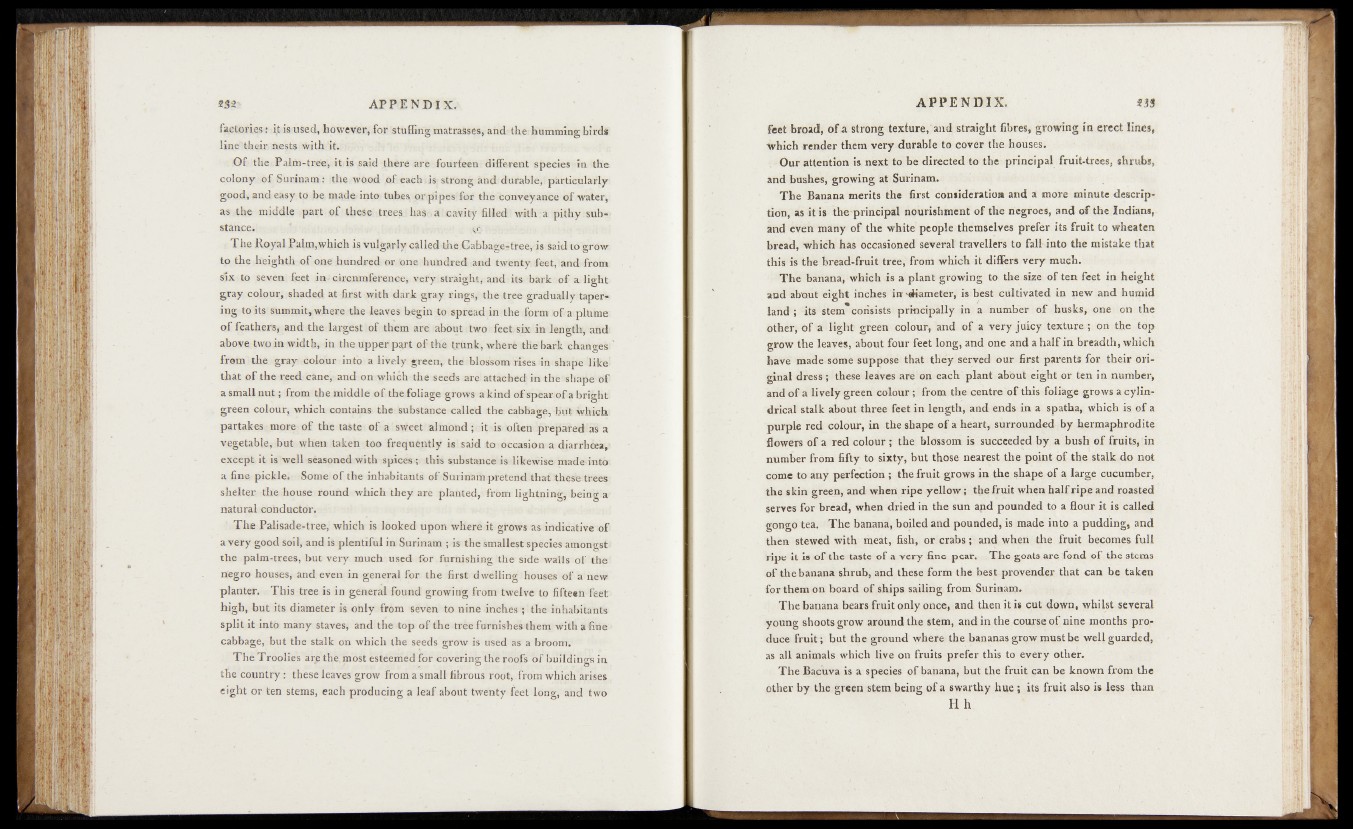
factories : fe feused, however* for JstiiSing matrasses,, and: the; humming birds
line'their nests with it. *• .
Of the; Palm-tree, itiis said there are. fourteen different species in the
cafohy of Surinam : the wood of each ds strong and durable, 1 particularly;
good, and easy to be made-into tubes or pipes-for th e conveyance of .water,
as . the middle part o f those; dreesd bafo a; eavifey filled with -a pithy. substance
« i •: .-hfo w -.{hSiI a- ÜÈPffîë
I The Royal Palm,which is vulgarly calledlhe Gahhageitree^is said to grow
tp the heighth of cme hundred or. pne hundred and twenty feet, and from
six to seven feet in-cirohraferenoe, very straight} and its-bark of a light
gray colour} shaded at first with dark gray rings, the tree graduallytaper-
ing to its summit, where the leaves begin to spread in the form o f aipllime:
o f feathers} and the largest of them are about ;two feet> six in length, aiidi
above two in width, in the upper part o f the trunk, wberé the bark changes
from the grayHCoJourdntb a lively green-,, the blossom rises in shape like^
that o f the reed cane, and on which the seeds are attached; in theashape'O'fi
a small nut ; from the middle of the foliage grows a kind of spear.of a brighti
green colour, which contains the substance called the cabbage, Hutfehich;
partakes more o f the taste of-a svteet almond ; it is-'often prepared as a
vegetable,--but when taken :too frequently is said torocoasiona diiarxhoeay!
except it is well seasoned with spices-ajthis substance is likewise- feadeiinto;
a fine, pickle«- Some of the inhabitants oTSurinàm pretenddhaëthêdfe.-trees
shelter the house round which they are planted, from lightning, beifl^ia'
natural conductor.
The Palisade-tree, which is looked upon where it grows as indicative .of
a very good Soil, and is plentiful in Surinam ; is the smallest spècies amongst;
the palm-trees, but very; much used for furnishing-the side walls-of’the'
riegro- houses, and. even in general for the first dwelling houses of a:new.
planter. This tree is in general found growing from twelve to fifteen feet,
high, but its diameter is only from seven to nine dnehes-;* the inhabitants
split it into many staves, and the top of the tree fttWusbeS them with a fine*
cabbage, but the stalk on which the seeds grow is used as a broonf.1 "
Thé TrOolies arg the, most esteemed for covering thé roofs of buildings in
tne country : these leaves grow from a small fibrous root, Trom which arises
eight or ten stems, each producing a leaf about twenty feet long, and two
feet broad, of a strong texture, and straight fibres, growing in erect lines,
’Which -render them very durable to cover tire houses.
Our attention is next to be directed to the principal fruit-trees, shrubs,
and bushes, growing at Surinam.
The Banana merits the first consideration and at more minute description,
as it is the'principal nourishment of the negroes, and of the Indians,
and even many of the white people themselves prefer its fruit to wheaten
bread, which has occasioned several travellers to fail into the mistake that
this is the bread-fruit tree,' from which it differs very much.
The banana, which -is a plant growing to the size of ten feet in height
and about eight inches in 'diameter, is best cultivated in new and humid
land ; its stem*consists principally in a namber of husks, one- on the
other, o f a light* green colour, and o f a very juicy texture; on the top
grow the leaves, about four feet long, and one and a half in breadth, which
have made-some suppose that they served our first parents for their original
dress ; these leaves are on each plant about eight or ten in number*
and of a lively green colour; from the centre of this foliage grows a cylindrical
stalk about three feet in length, and ends in a spatha, which is of a
purple red colour, in the shape of a heart, surrounded by hermaphrodite
flowers of a red colour; the blossom is succeeded by a bush of- fruits, in
number from fifty to sixty, but those nearest the point of the stalk,do not
come to any perfection ; the fruit grows in the shape o f a large cucumber,
the skin green, and when ripe yellow; the fruit when half ripe and roasted
serves for bread, when dried in the sun apd pounded to a flour it is called
gongo tea. The banana, boiled and pounded, is made into a pudding, and
then stewed with meat, fish, or crabs; and when the fruit becomes full
ripe it is o f the taste of a very fine pear. The goats are fond o f the stems
of the banana shrub, and these form the best-provender that can be taken
for them on board of ships sailing from Surinam* ftjjj
The banana bears fruit only once, and then it is cut down, whilst several
young shoots grow around the stem, and in the course o f nine months pror
ducë fruit ; but the ground whère the bananas grow must be well guarded,
as all animals which live on fruits prefer this to every other..
The Bacuva is a species of banana, but the fruit can be known from the
other by the green stem being of a swarthy h u e» its fruit also is less than
Hh;